Characterizing the Preservation Potential of Buried Marine Archaeological Sites
Abstract
:1. Introduction
- The extent of the site to be preserved;
- The most significant physical, chemical and biological threats to the site;
- The types of materials present on-site and their state of preservation;
- Strategies to mitigate deterioration and stabilize the site from natural impacts; and
- Subsequent monitoring of the site and the implemented mitigation strategies.
2. Scientific Background
Deterioration of Organic Material in Marine Sediments
3. Materials and Methods
3.1. Characterizing the Preservation Potential of Archaeological Material in Marine Sediments
- Characterizing the environment to assess whether it is oxic or anoxic and determine the dominant process ongoing in the sediments. This was done both through in situ profiling using an in situ sediment profiling data logger and ex situ, using sediments taken with a diver-held vibracorer. The parameters assessed are listed in Table 1 and Table 2.
- Laboratory mesocosm studies with broadly different sediment types (e.g., sand, gytje and “polluted” (high organic content) harbor sediments) to see if there was a difference in the rates of turnover of material.
3.2. Characterizing the Burial Environment to Determine whether It Is Oxic or Anoxic
3.2.1. In Situ Sediment Profiler
3.2.2. Ex Situ Assessment (Sediment Cores) Using a Diver-Held Vibracorer
3.3. Sediment Characterisation
3.4. Mesocosm Studies of Organic Turnover in Different Sediment Types
4. Results
4.1. Characterizing the Environment to Determine whether It Is Oxic or Anoxic: In Situ Profiling
4.2. Ex Situ Assessment (Sediment Cores)
4.2.1. Microsensor Profiling
4.2.2. Pore Water Analysis
4.2.3. Sediment Characterization
4.2.4. Mesocosm Studies
4.2.5. Carbon-14 Dating of Wood and Organic Fragments from Tudse Hage Core
5. Discussion
5.1. Dissolved Oxygen
5.2. Sulfate Reduction and the Measurement of Hydrogen Sulfide
5.3. Physical Characterisation of Sediment Type and Ongoing Processes
6. Conclusions
- In situ classification of sediments;
- Ex situ classification of sediments;
- Laboratory microcosm studies examining turnover rates in different sediments;
- Characterization of the actual state of preservation of archaeological wood and dating.
Funding
Acknowledgments
Conflicts of Interest
References
- European Convention on the Protection of the Archaeological Heritage (Revised). 1992. Available online: https://rm.coe.int/CoERMPublicCommonSearchServices/DisplayDCTMContent?documentId=090000168007bd25 (accessed on 15 July 2020).
- UNESCO. Unesco Convention on the Protection of the Underwater Cultural Heritage. 2001. Available online: http://www.unesco.org/new/en/culture/themes/underwater-cultural-heritage/2001-convention/official-text/ (accessed on 15 July 2020).
- Gregory, D.J. Environmental Monitoring of the re-burial trenches 2007–2009. In Reburial and Analysis of Archaeological Remains. The RAAR Project: Phase II—Results from the 4th Retrieval in 2009 from Marstrand, Sweden; Godfrey, I.N., Bergstrand, T., Petersson, H., Eds.; Bohusläns Museum: Uddevalla, Sweden, 2011; Volume 28. [Google Scholar]
- Manders, M. Protecting common maritime heritage. The Netherlands involved in two EU-projects: MoSS and BACPOLES. In Mediterraneum; Maniscalco, F., Ed.; Massa Editore: Naples, Italy, 2004; pp. 279–292. [Google Scholar]
- Manders, M. MACHU—Managing Cultural Heritage Underwater. 2010. Available online: https://www.machuproject.eu/ (accessed on 15 July 2020).
- Björdal, C.G.; Gregory, D. Wreck Protect: Decay and Protection of Archaeological Wooden Shipwrecks; Archaeopress: Oxford, UK, 2012. [Google Scholar]
- Gregory, D. In situ preservation of marine archaeological sites: Out of sight but not out of mind. In In Situ Conservation of Cultural Heritage: Public, Professionals and Preservation; Richards, V., Mckinnon, J., Eds.; Flinders University: Adelaide, Australia, 2009; pp. 1–16. [Google Scholar]
- SASMAP Project Home Page. Available online: http://www.sasmap.eu (accessed on 15 July 2020).
- Gregory, D.; Manders, M. Best Practices for Locating, Surveying, Assessing, Monitoring and Preserving Underwater Archaeological Sites. SASMAP Guidel. Man. 2016, 2. Available online: http://sasmap.eu/fileadmin/user_upload/temasites/sas_map/pdf/SASMAP_guideline_02_LR.pdf (accessed on 18 July 2020).
- Rullkötter, J. Organic Matter: The Driving Force for Early Diagenesis. In Marine Geochemistry; Schulz, H.D., Zabel, M., Eds.; Springer: Berlin, Germany, 2000; pp. 129–153. [Google Scholar]
- Schulz, H.D. Redox Measurements in Marine Sediments. In Redox: Fundamentals, Processes and Applications; Schűring, J., Schulz, H.D., Fischer, W.R., Bõttcher, J., Duijnisveld, W.H.N., Eds.; Springer: Berlin, Germany, 2000; pp. 235–246. [Google Scholar]
- Froelich, P.N.; Klinkhammer, G.P.; Bender, M.L.; Luedtke, N.A.; Heath, G.R.; Cullen, D.; Dauphin, P.; Hammond, D.; Hartman, B.; Maynard, V. Early Oxidation of Organic Matter in Pelagic Sediments of the Eastern Equatorial Atlantic: Suboxic Diagenesis. Geochim. Cosmochim. Acta 1979, 43, 1075–1090. [Google Scholar] [CrossRef]
- Lotz, P. Tudse Hage—An underwater settlement on Sjælland. Marit. Archaeol. Newsl. Rosk. Den. 2000, 14, 8–13. [Google Scholar]
- Richards, V. In situ preservation and monitoring of the James Matthews shipwreck site. Conserv. Manag. Archaeol. Sites 2012, 14, 169–181. [Google Scholar] [CrossRef]
- Available online: https://www.unisense.com/manuals/ (accessed on 15 July 2020).
- Jørgensen, B.B. Mineralisation of Organic Matter in the Sea Bed—The Role of Sulphate Reduction. Nature 1982, 296, 643–645. [Google Scholar] [CrossRef]
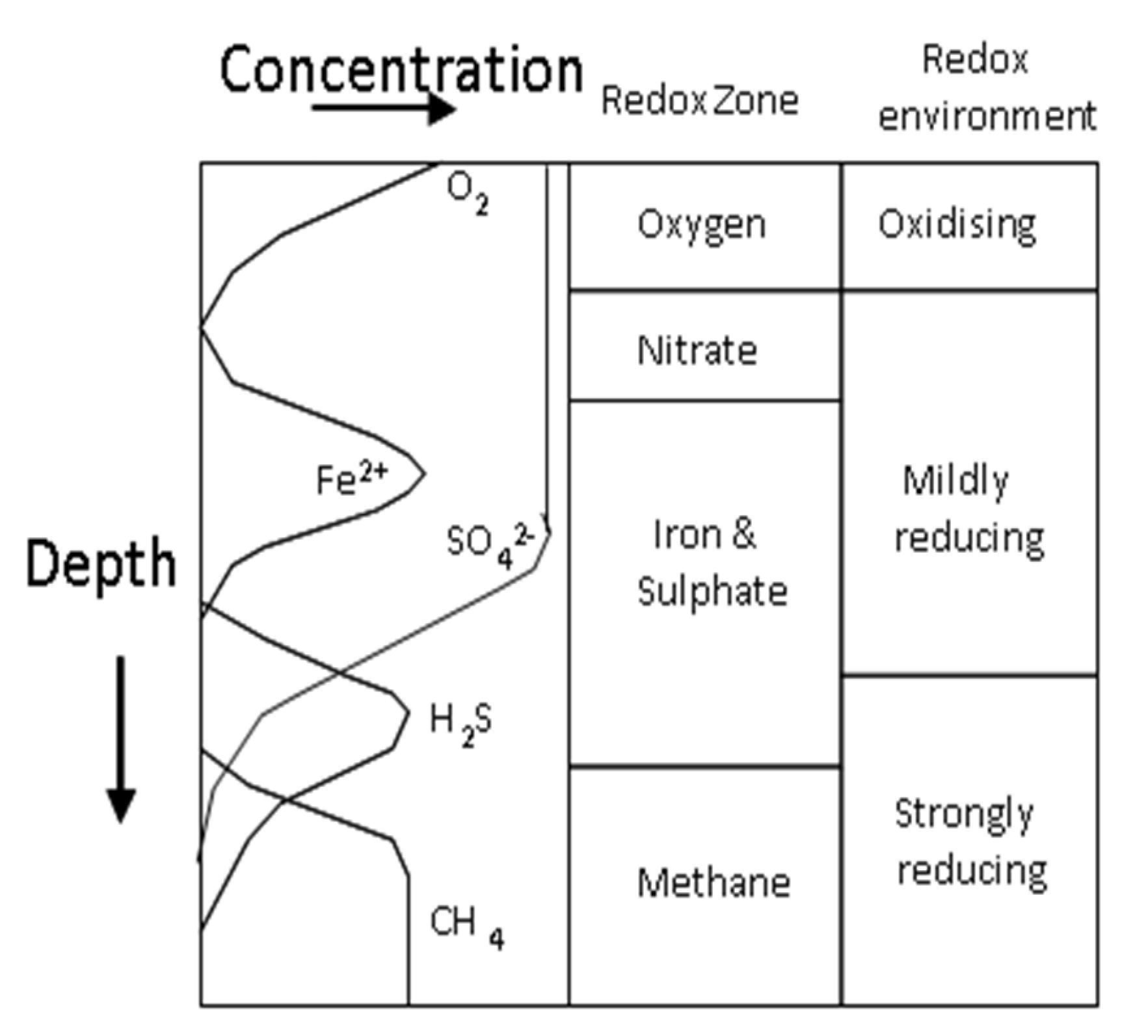


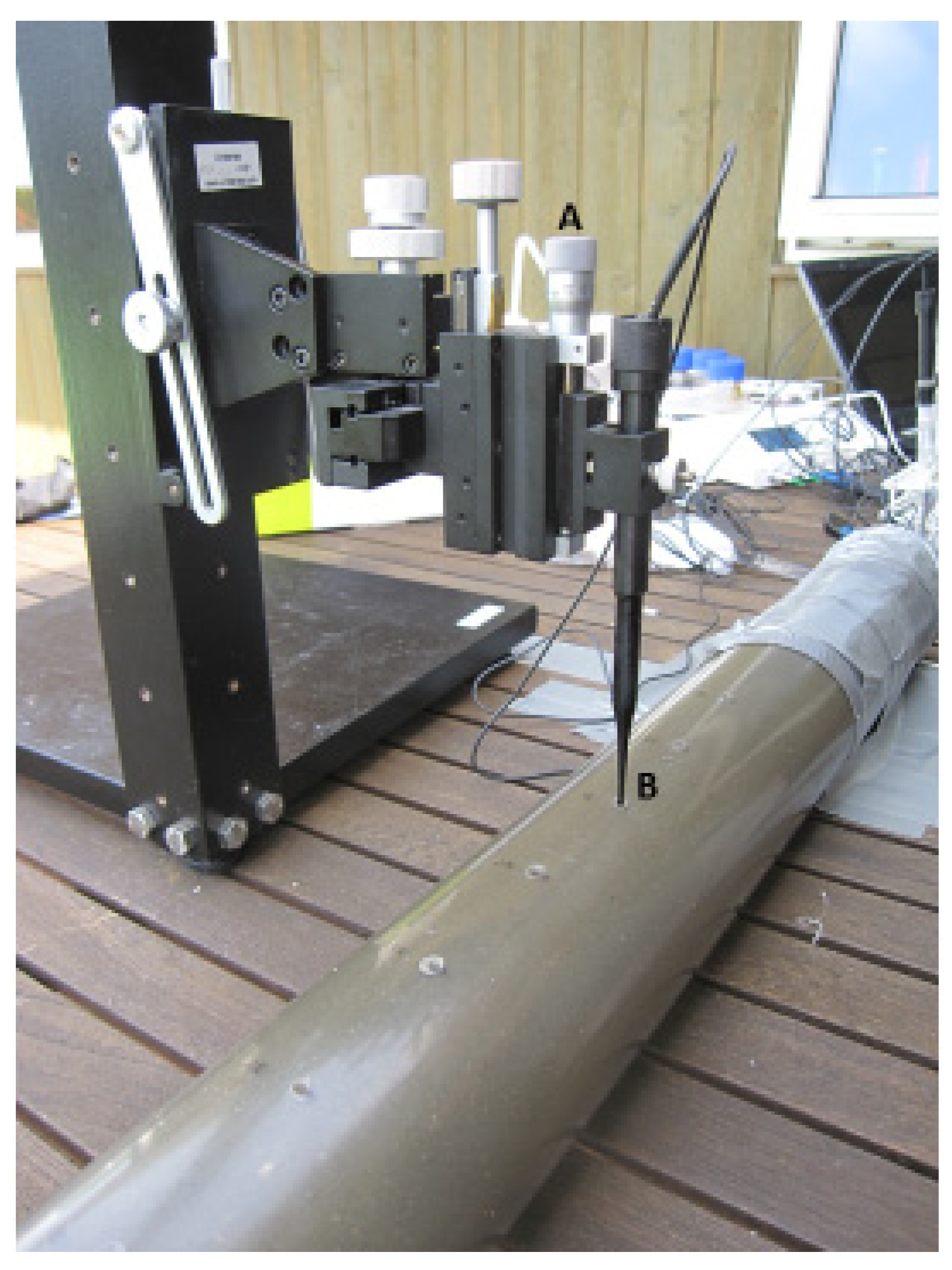
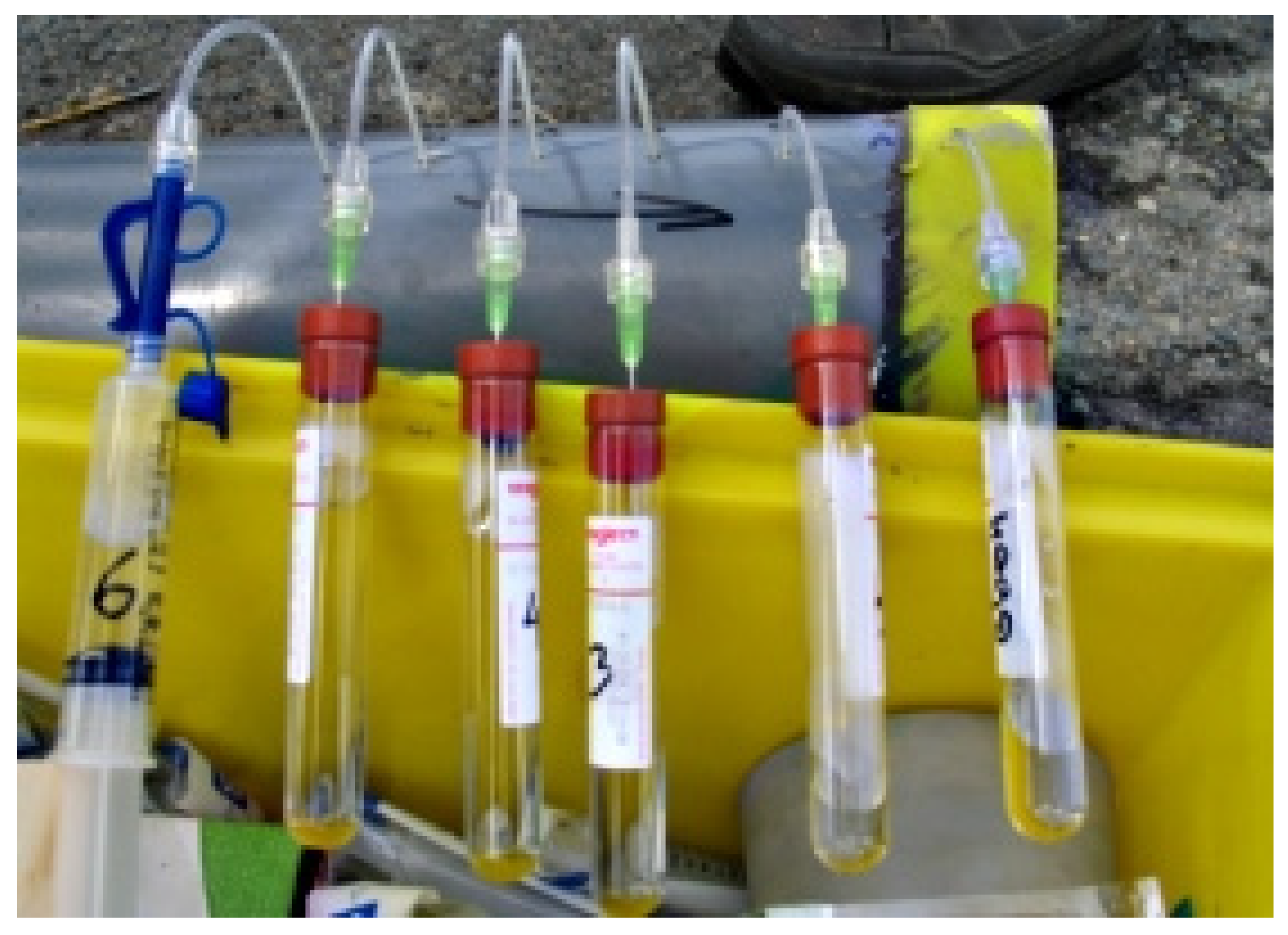
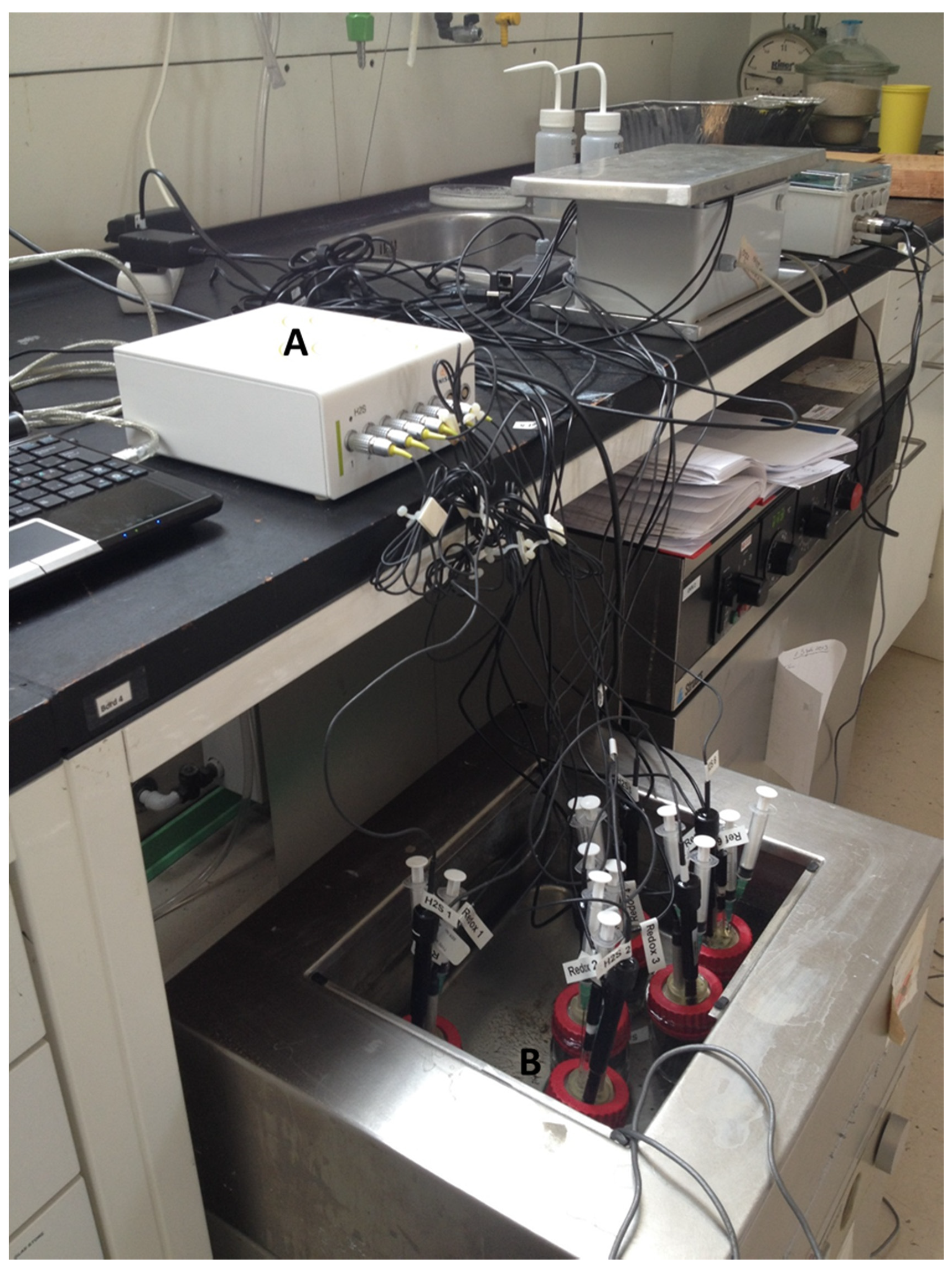
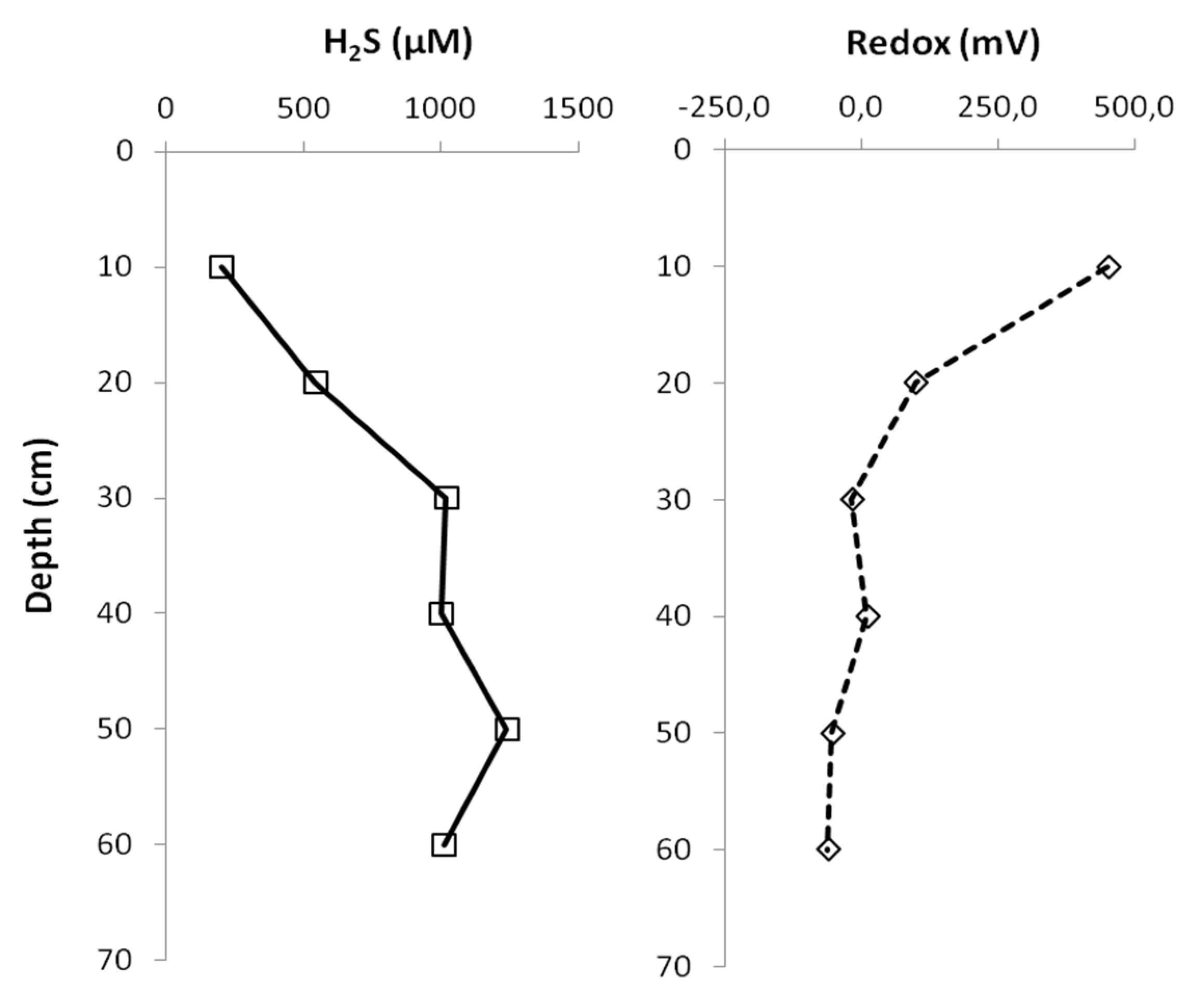
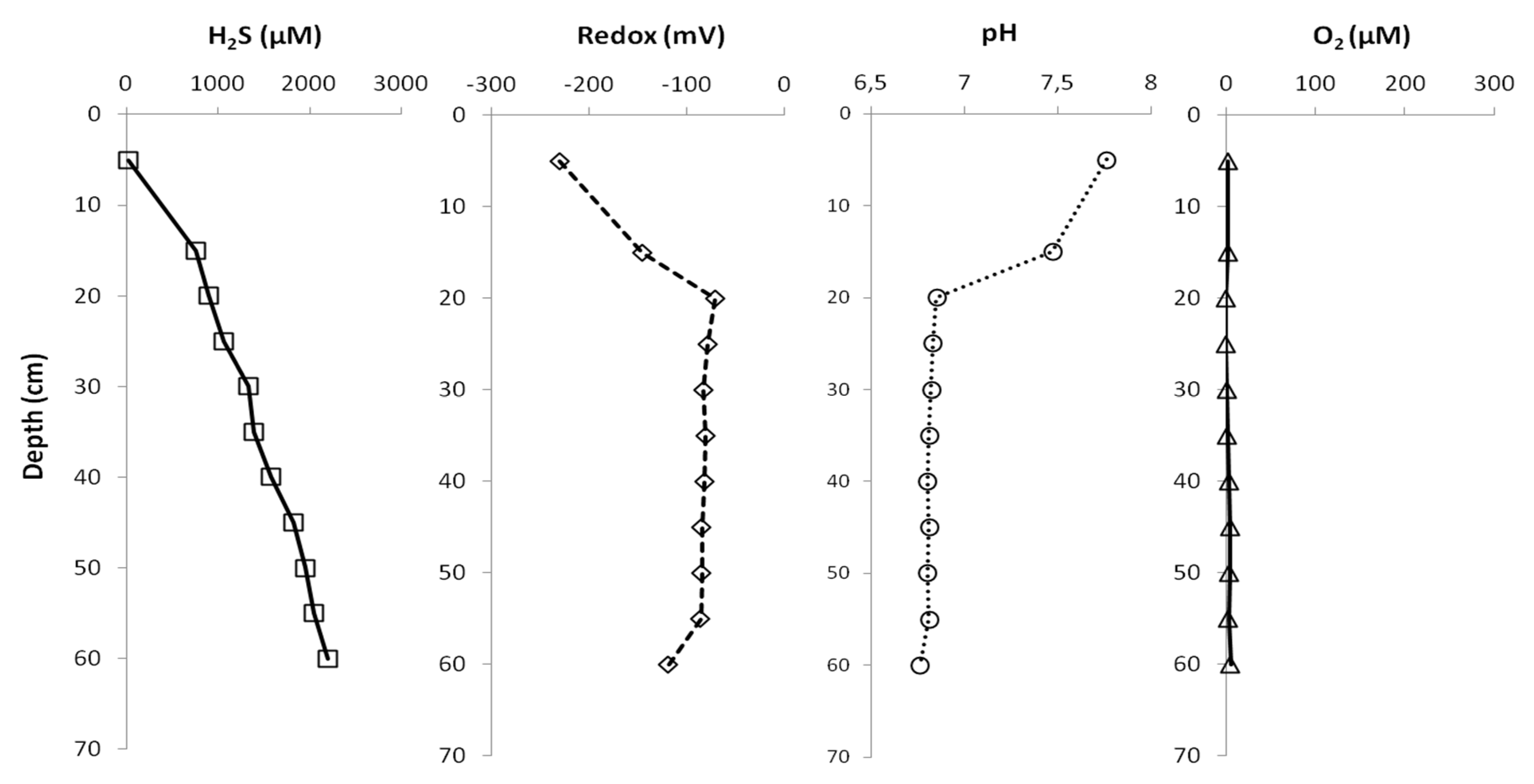
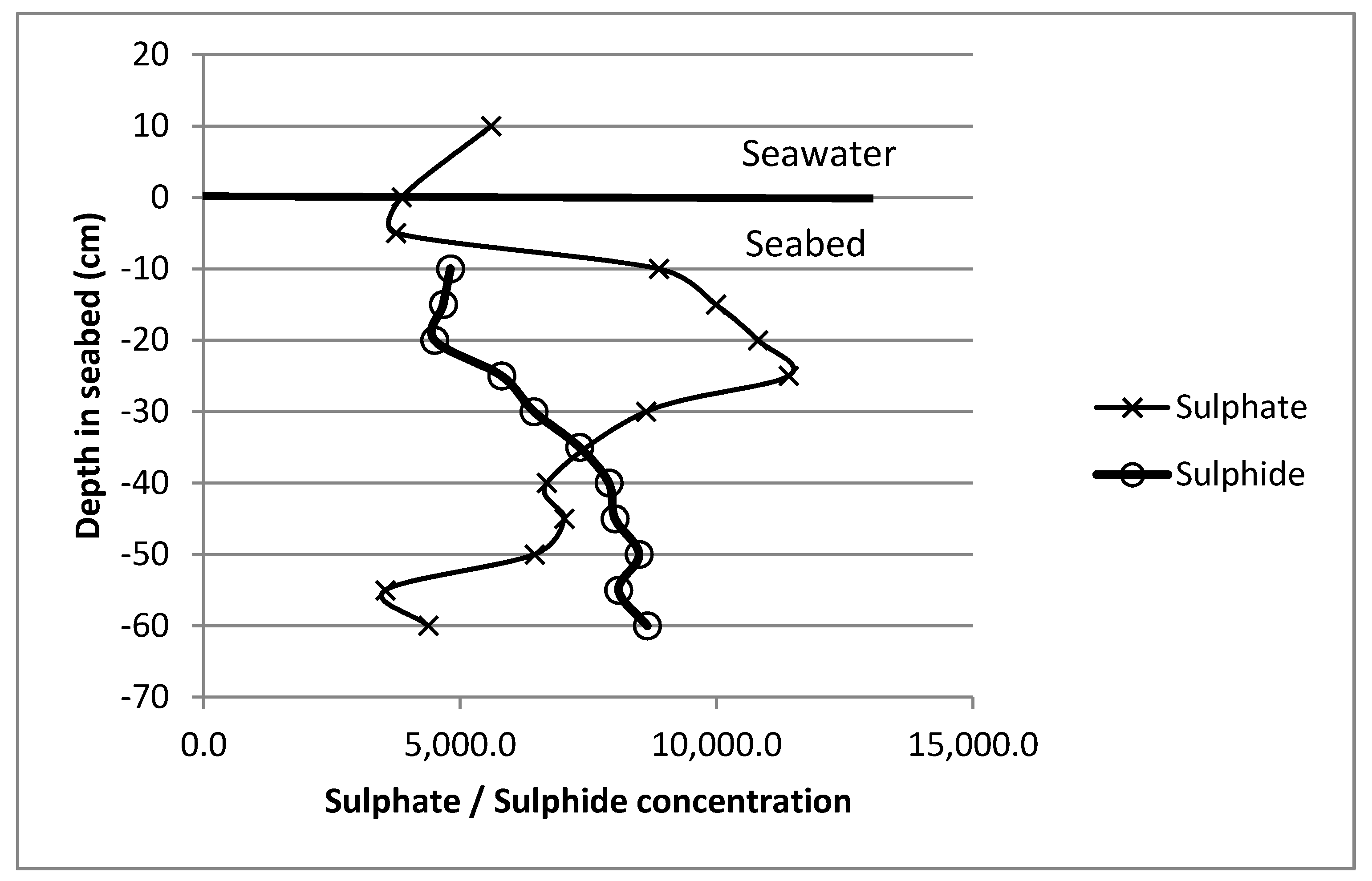
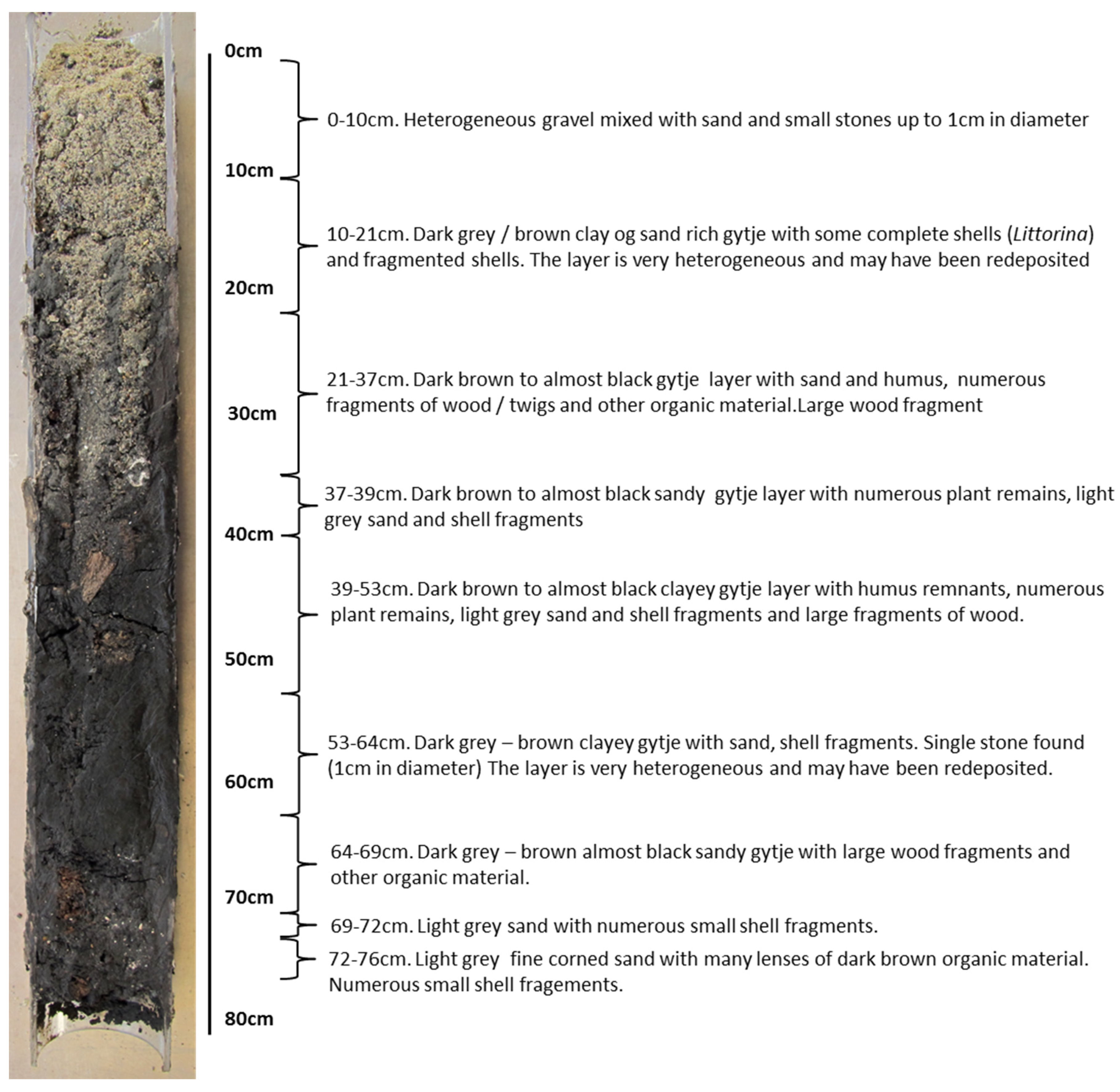
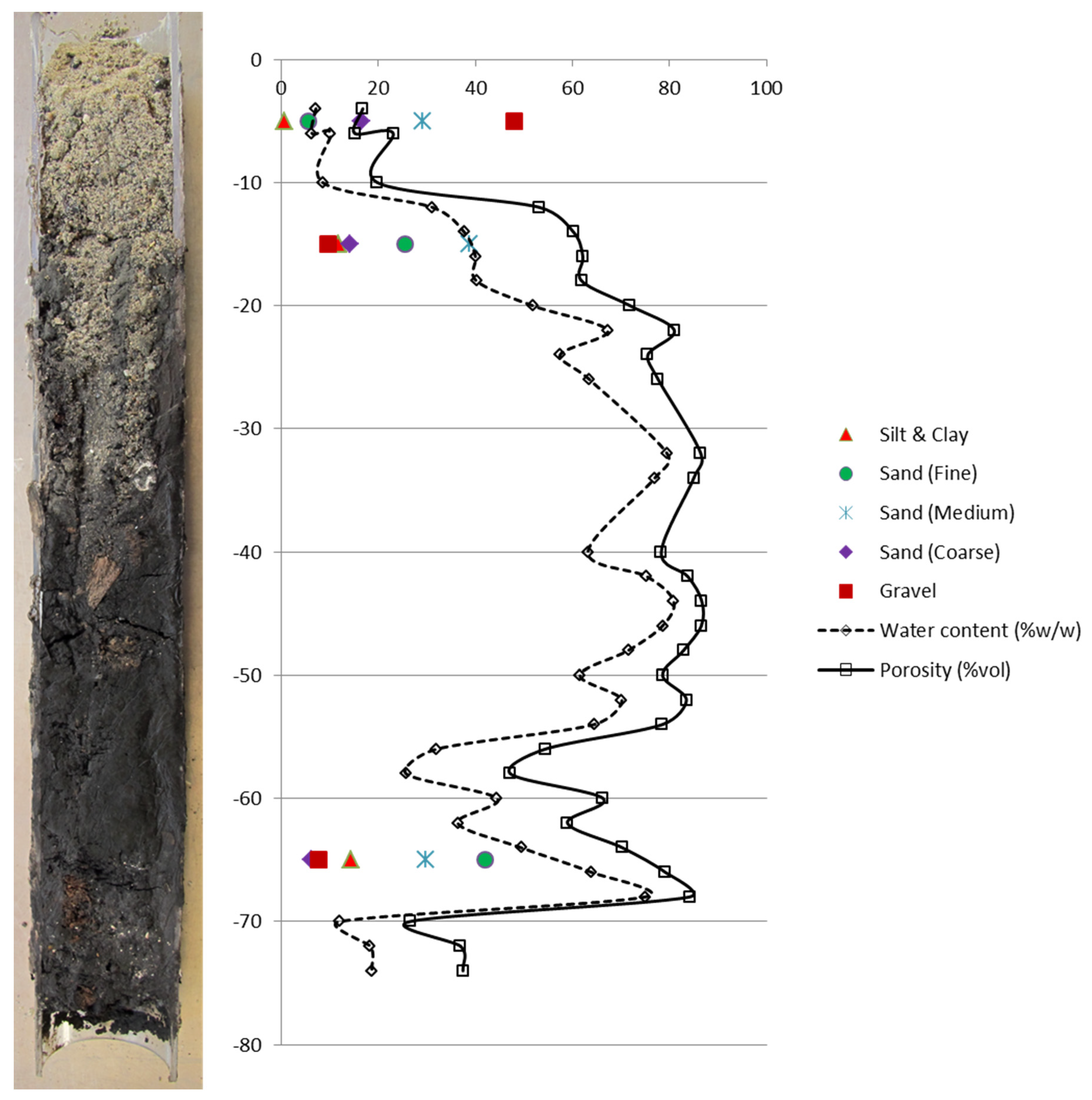
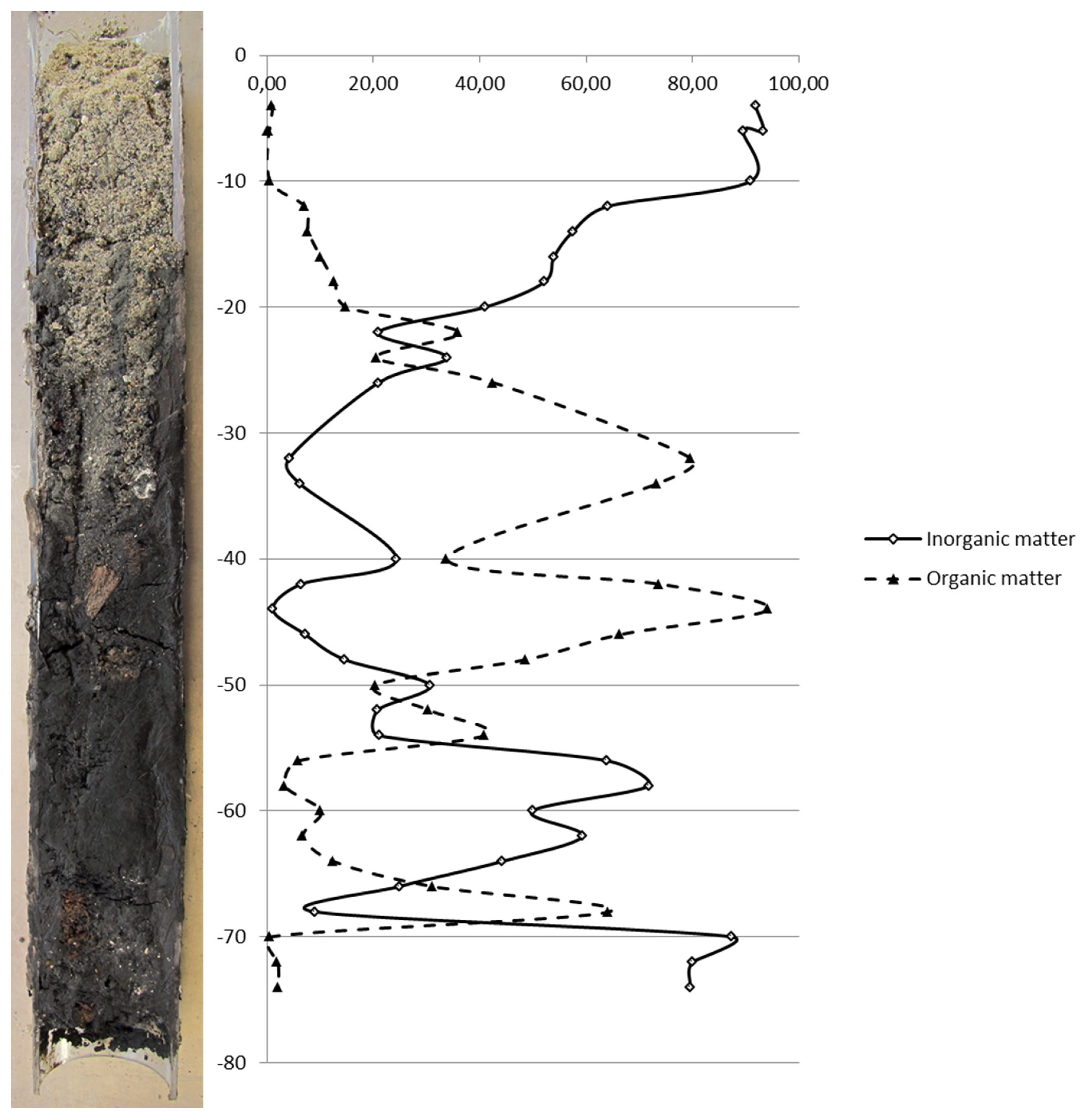
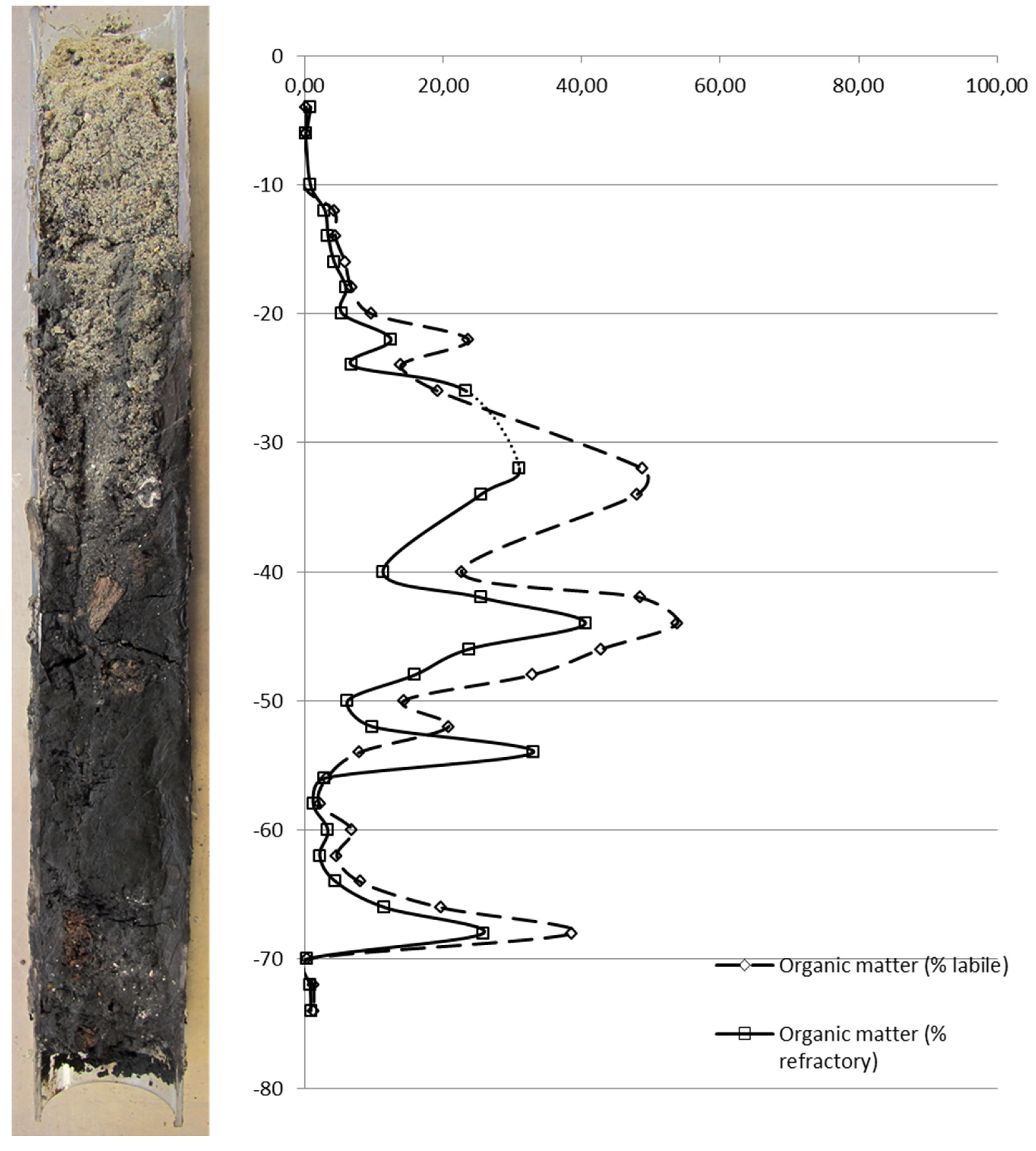
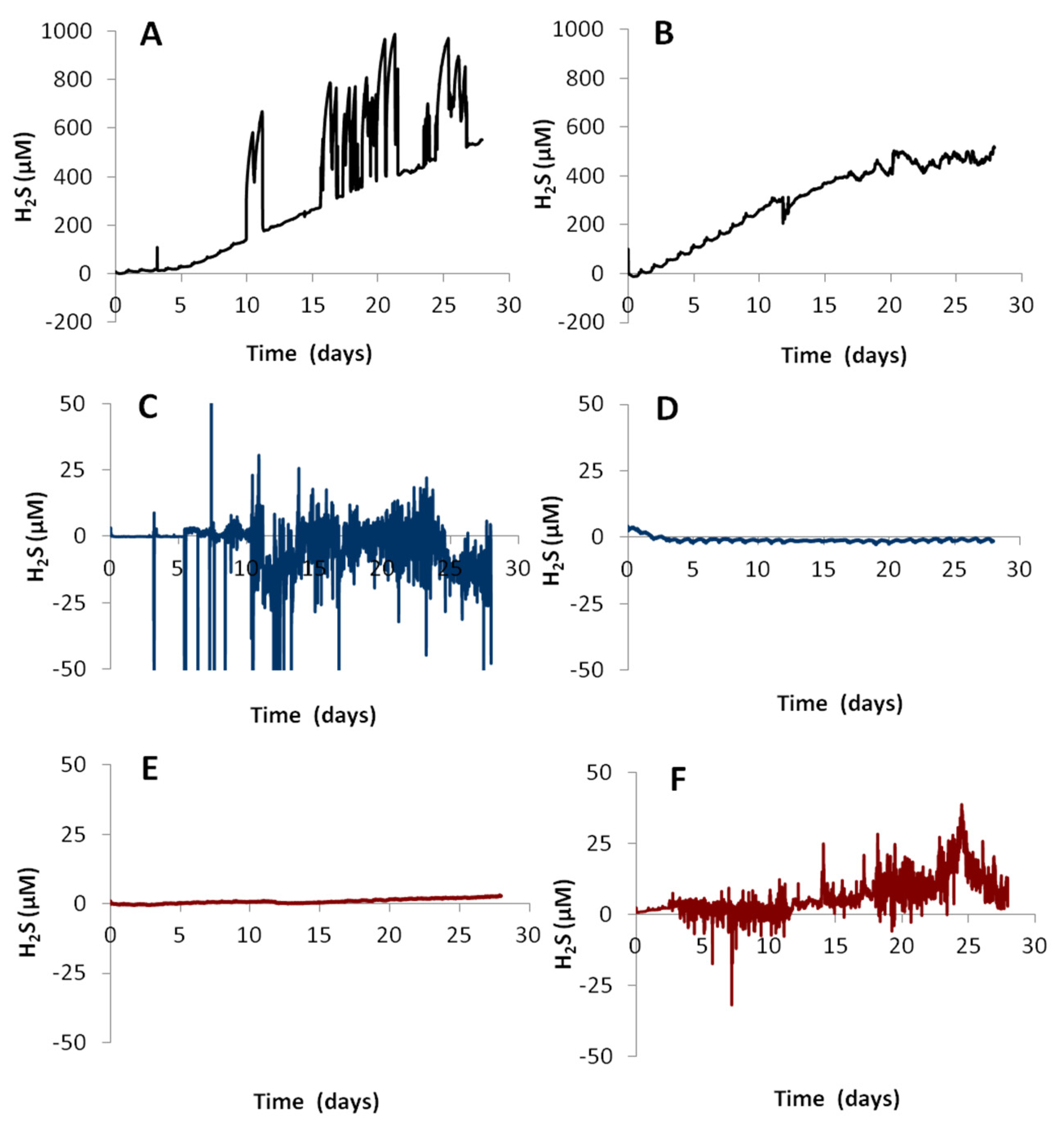
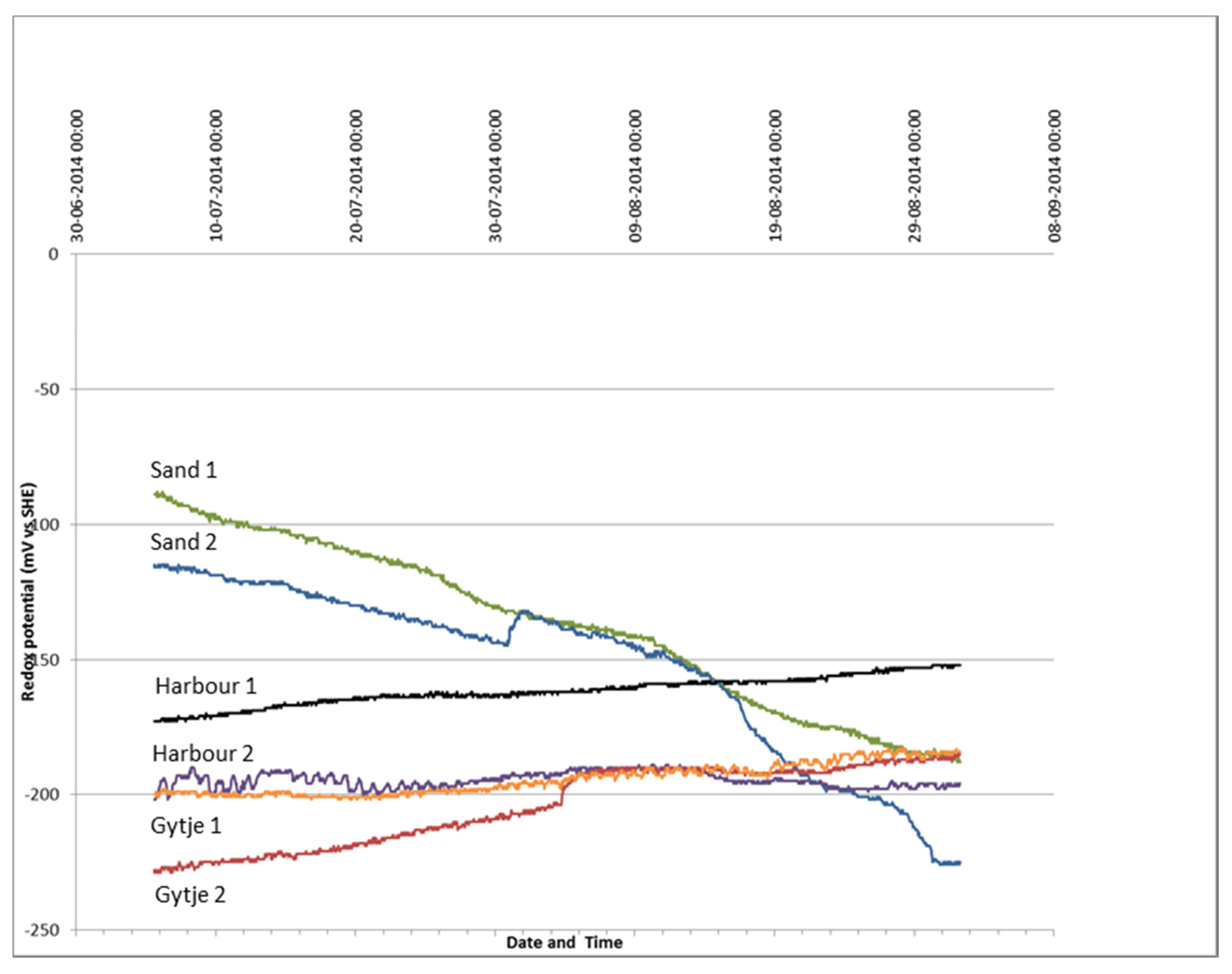
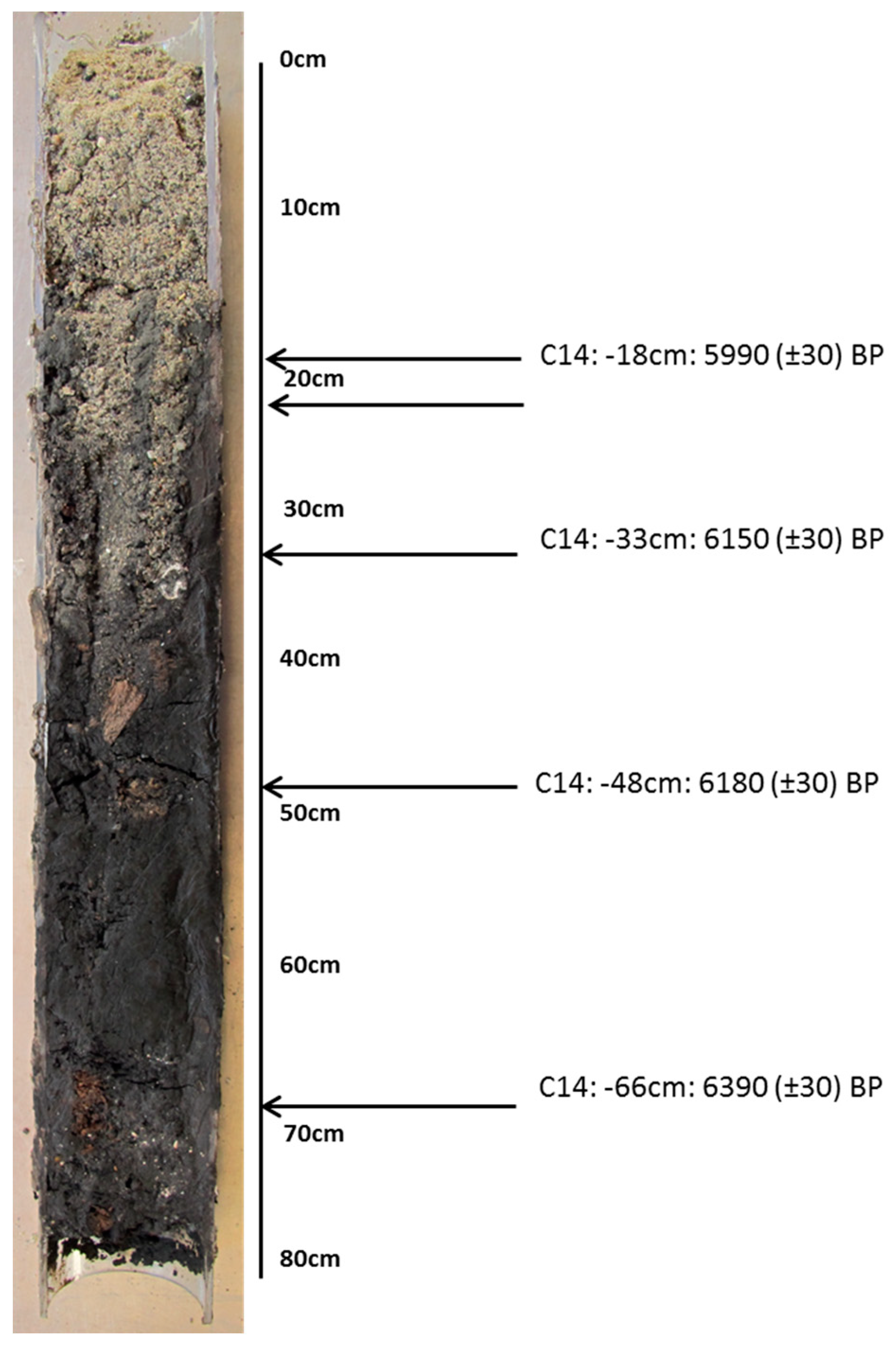


| Parameter | In Situ (Sediment Profiler) | Ex Situ (Sediment Core) |
|---|---|---|
| Dissolved oxygen | X | |
| pH | (X) | X |
| Sulfide content | X | X |
| Redox potential | X | X |
| Sulfate content | X (pore water) |
| Sediment Parameter |
|---|
| Visual characterization |
| Water content |
| Particle size analysis |
| Porosity |
| Organic content |
| Weight% | |||
|---|---|---|---|
| 0–10 cm | 10–20 cm | 60–70 cm | |
| Silt and clay (<0.063 mm) | 0.66 | 11.90 | 14.34 |
| Sand, fire (0.0063–02 mm) | 5.54 | 25.49 | 41.92 |
| Sand, medium (0.2–0.6 mm) | 29.12 | 38.81 | 29.76 |
| Sand, coarse (0.6–2 mm) | 16.62 | 14.19 | 6.17 |
| Gravel (>2 mm) | 48.07 | 9.60 | 7.81 |
| Sediment Type | Particle Size (mm) | Harbor | Sand | Gytje |
|---|---|---|---|---|
| Silt & Clay | <0.063 | 43.1 | 0.4 | 84.8 |
| Sand, Fine | 0.063–0.2 | 44.3 | 80.4 | 5.0 |
| Sand, Medium | 0.2–0.6 | 9.5 | 17.2 | 9.1 |
| Sand, Coarse | 0.5–2 | 1.5 | 1.5 | 1.2 |
| Gravel | > 2 | 1.5 | 0.6 | 0.0 |
| Water content (%) | 64.3 | 17.5 | 56.3 | |
| Organic Content (%) | 6.7 (L: 2.8 R: 3.9) | 0.5 (L: 0.1 R: 0.4) | 11.5 (L: 5.8 R: 5.6) | |
| Inorganic content (%) | 93.3 | 99.5 | 88.5 | |
| Sulfide content (µMoles) | 1927 | 43.5 | 0.7 |
© 2020 by the author. Licensee MDPI, Basel, Switzerland. This article is an open access article distributed under the terms and conditions of the Creative Commons Attribution (CC BY) license (http://creativecommons.org/licenses/by/4.0/).
Share and Cite
Gregory, D. Characterizing the Preservation Potential of Buried Marine Archaeological Sites. Heritage 2020, 3, 838-857. https://doi.org/10.3390/heritage3030046
Gregory D. Characterizing the Preservation Potential of Buried Marine Archaeological Sites. Heritage. 2020; 3(3):838-857. https://doi.org/10.3390/heritage3030046
Chicago/Turabian StyleGregory, David. 2020. "Characterizing the Preservation Potential of Buried Marine Archaeological Sites" Heritage 3, no. 3: 838-857. https://doi.org/10.3390/heritage3030046
APA StyleGregory, D. (2020). Characterizing the Preservation Potential of Buried Marine Archaeological Sites. Heritage, 3(3), 838-857. https://doi.org/10.3390/heritage3030046




